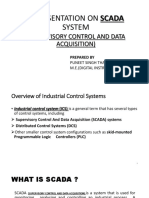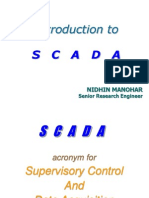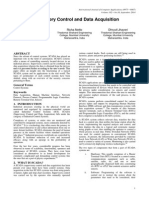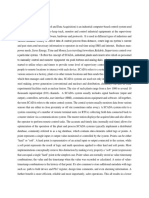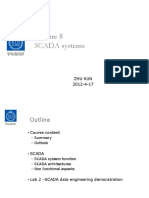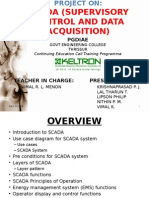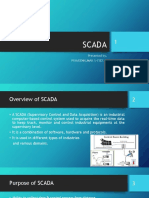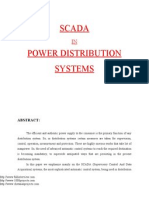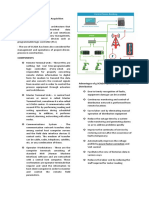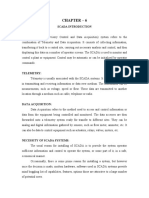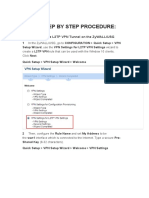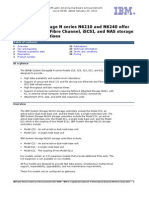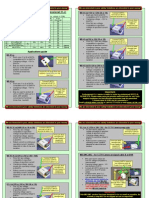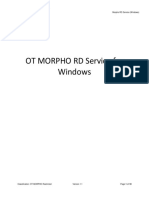14/10/2024
SCADA (supervisory control and data
acquisition) is a control system architecture
SCADA and Central Applications comprising computers, networked data
An introduction communications and graphical user interfaces
for high-level supervision of machines and
processes. It also covers sensors and other
devices, such as programmable logic
controllers, which interface with process plant
or machinery.
Course map
SCADA and PLC Overview
1
� 14/10/2024
Outline of the lecture Power System Operation
• System-wide monitoring, planning & optimisation
• Power System Operation for reliable and cost efficient operation of the
- Centralised Control Applications - an example power system
• Time scale: seconds to hours.
• SCADA
- SCADA architecture & Components
- SCADA system functions
- Non functional aspects
Normal
Restorative Alerted
Emergency
Deregulation– in theory Deregulation – in practice
Area 4
GenCo GenCo GenCo GenCo Area 5
Area 2
Wholesale level - Transmission
Customer
Retailer Retailer
Retail level - Distribution
Area 1 Area 3
Customer Customer Customer Customer
2
� 14/10/2024
Coordination between actors Example – root event
1.Step-up transformer
insulation fault
2.Fault is detected by
protection system
3.Trip signal sent to
breaker to disconnect
generator
TSO - Frequency control
3. TSO - Maintenence
2. 1.
TSO - Frequency Control TSO- Repair & Maintenance
1. Frequency dip detected at
generators committed to
3. Load Frequency Control 1. 1. Fault in transformer sent
leads to automatic 2. from SCADA system to work
6. 5.
increase of output management system using
2. Continuous under- e.g. IEC 61968-4
TSO frequency measured are
3.
2. Repair crew sent to site
sent to SCADA system from work dispatch
using IEC 60870-5-101
3. At site, work crew reports
2. 3. Control room operator to control centre to initiate
activates secondary safe switching sequences
reserve by issuing order
4. Station set to manual
to GenCo via phone. 4. control, fault repaired (!) or
4. 4. GenCo orders production report initiated for major
1. increase in secondary overhaul.
reserve.
5. After completed
5. Order for production assignment, info on failure
GenCO 1. increase sent to plant stored in maintenance
from GenCo CC. database.
5 1. 6. New measurements sent
to neighbouring Grid
Utility using ICCP.
3
� 14/10/2024
Central control & coordination Power System Control Center Functionality
• On the deregulated Power market, all actors •Three groups of functions on SCADA
- Distribution Network Operators - Business Management
- Transmission Network Operators
- Generating companies - Energy Management
- Generation management
• All need some central platform to manage their
assets dispersed across large areas.
• Enter – the SCADA system
BMS EMS GMS
SCADA
What is SCADA? The typical control room
Supervisory Control And Data Acquistion
- Collect measurements and status data from the process
- Remotely intervene in the process
- Centralized system platform
- Based on distributed I/O
Applicable Processes
- Oil or Gas prodcution facilities
- Piplelines for gas, oils, chemicals or water.
- Railway/Transportation Process
- Nuclear, Gas, Hyrdo generation plants
Example of SCADA used in office environment to remotely monitor a
process
4
� 14/10/2024
What is controlled by SCADA SCADA architecture
Tap changers
Switching devices
Shunt capacitor/reactor
Generator setpoints D_�(g p8o
Con r
Excitation & power output
Sequential control
App7cation Serve.
Reference: C37.1-2007 IEEE Standard for SCADA and Automation Systems
SCADA Components SCADA components
Human Machine Interface - HMI Application Servers
• Application servers provide the computing platform for
• Communication between operator the SCADA System, included servers are:
and machine - Real-time database
• Input - Historical database
- Mouse, keyboard, touch screen - Energy Management applications
• Output State Estimation
- Screen, audio, print-outs or mimic board Optimal/Dispatcher Powerflow
• A weak link Voltage Stability Assessment
- Information overload/misinterpretation Etc….
- Geographic Information Systems
Distribution Management
5
� 14/10/2024
SCADA Components Data Engineering
System Configuration Servers RUN TIME ENVIRONMENT RUN TIME ENVIRONMENT
DE 400
Data Entry
• Allows configuration of the SCADA system
A-
B-
environment, typical servers include: Graphical Editor C-
Forms
- Data engineering of the SCADA system providing manual
data entry into the SCADA topology database including
lidnes, circuitbreakers, stations, …..
Import
- SubstationdDevice configuration, such as IED Oracle Avanti Present
Customer's
configuration tools and databses of IED configuration. Data Source MDB Data Loading PDB
Remote access tools for configuration
Picture
generator Picture files
Data Engineering SCADA components
Communication Servers
RUN TIME ENVIRONMENT RUN TIME ENVIRONMENT • Variety of servers for communication
DE 400
- Communication to other Control centers using ICCP
Data Entry A-
- Communication to office applications
B-
Graphical Editor
C-
Forms
Import
Oracle Avanti Present
Customer's
MDB Data Loading PDB
Data Source
Picture
generator Picture files
6
� 14/10/2024
SCADA components SCADA Components
Communication Front End Remote Terminal Unit - RTU
• Manages communication with the field devices • A remote terminal unit (RTU) is a microprocessors-
• Supports communication with variety of protocols controlled electronic device that interfaces objects in the
physical world to a distributed control systems or SCADA
• Cyclic polling and event based communication, provides
by transmitting telemetry data to the system, and by
messages queuing
using messages from the supervisory system to control
connected objects.
Communication Topologies Networked solutions
• Radial serial circuit
• Multi-drop circuit Communication between Master Station (Front End) is
via TCP/IP over a shared Wide Are Network
Reference: C37.1-2007 IEEE Standard for SCADA and Automation Systems Reference: C37.1-2007 IEEE Standard for SCADA and Automation Systems
7
� 14/10/2024
Communication Principles Communication
• Wide Area Network
• Cyclic Polling - Analog point to point and multi-point modem networks
- Front-End communication server requests data periodically - Frame relay/Cell relay type point to point and multi-point
from each RTU. networks
- Period times vary from 2-4 up to 10-15 seconds. - Wireless Radio/Satellite networks
- Real-time? - Fiber-optic based networks
• Report By Exception • Protocols
- Cyclic polling as above - Modbus
- RTU only responds if a value has changed - Profibus
- IEC60870-5-101,104
• Balanced protocols - DNP 3
- The RTU can send a request to be polled by the Front-End - IEC61850-90-2
- IEC60870-6-ICCP (between control centers)
Distributed Network Protocol (DNP) IEC 60870-5-101/104
• Designed specifically for SCADA systems, i.e. a data
acquisition and control communication protocol • International standards for open transmission of SCADA telemetry
and control information
• Predominantly a SCADA to RTU/IED or RTU/IED to
RTU/IED communication
• Provides detailed functional description for telecontrol equipment
• Used in Electric automation and prominent in the and systems for controlling geographically widespread processes
North and South America, Australia and specifically intended for electrical industries
• Open Standard, not owned or control by a single
• When reference to 60870-5 in the context of SCADA systems is
private organization. All vendors have a say in the
made it is usually for 60870-5-101/104 titled “Companion
design and specification Standard for basic telecontrol tasks.
• 101 protocol intended for transport of data over serial links
• 104 protocol is a TCP/IP implementation of 101.
8
� 14/10/2024
IEC 60870-6 IEC 61850-90-2
• Inter Control-center Protocol (ICCP) or TASE.2 • Using Logical Nodes and Attributes from IEC 61850 also in
• To enable data exchange between control centers of: the SCADA system.
- Measurements • Data is carried in MMS over TCP/IP
- Time-tagged data, measurement series
- Events
• Some variants exist, latest version TASE.2 based on
MMS most popular presently.
SCADA functions Data acquisition
• Points
Data acquisition - Measured values
Analog and discrete values
• Pseudo points
Event and alarm processing
- Derived values
Event and alarm
Control • Scan
Tap changer - process by which data
Shut capacitor/reactor acquisition system
interrogates RTU/IED
Switching devices
Generator excitation (AGC) • Scanning rate
- 1 sample/2 seconds
Data storage, archiving and analysis
• Time skew
- elapsed time between the
first measurement and the
final measurement is
taken
Reference: North-Corte Green Control & Automation of Electric Power Distribution Systems
9
� 14/10/2024
SCADA: Data Acquisition (Cont.) Monitoring and Event Processing
Measurements and Status Indications Collected are Events
stored in a Real Time Database. Changing positions
Breaker / Disconnector opens or closes
The Values are Time tagged in the database. Value above/below a threshold
Equipment activated
Reactor or capacitor engaged
As new Values come in from the RTUs/IEDs old values Automatic changes
are overwritten (or archived).
On load tap changer changes state
Alarms
Critical events
It is a matter of definition
Alarm and Event Management Event and alarm
Alarm list
Events
Changing positions
– Breaker/Disconnector opens or closes
– Value above/below a threshold
Equipment activated
– Reactor or capacitor engaged
Breaker Automatic changes
opens – tap changer changes its position
Alarms
– Criticality
Event list – Sensitivity
10
� 14/10/2024
Monitoring and Event Processing (cont.) Time stamping
Limit values Limit value Zero value Monitor lng with
monitoring monitoring a deadband
Upper meterlng limlt • Sequence of events is often important in analysis of
Upp er alarm zone
pper a larrn Ii nut chains of events
Upper warning zone
Upper warning limit ---- -----_}
• Time stamping of Events
Zone or normal - As close as possible to the source. For example the IED
operation
that collected the measurement
Lower warning limit
------ Lower warning zone
- Requires time synchronisation of distributed devices
- Additional Time-stamp at Front-End
---1
Outside zero-zon e Event generated
Lower alarm limit
Lower alarm zone
Lov 'er metering limit �
-} ' \Xrthin zero-zone
}
0 • • • 0 • I • I •
(zero deadband]
Zero value
t t
Reference: North-Corte Green Control & Automation of Power Distribution Systems
Electric
SCADA: Data Storage, Archiving and
Analysis
Sequence of Events recorders
• Local function implemented in Substation Controller
• Data Collected from the process is sometimes that keeps a record of all events in the substation
archived, this due to many reasons:
Regulations • Not all events are sent to the SCADA system
Billing
Future Load planning • SER logfiles can be uploaded to the SCADA system to
Performance Audits enable analysis
Post Mortem Review, in case of disturbances or
interruptions in the process.
Changed Values are “archived” at cyclic intervals,
the interval depends on the importance of the
values. Examples of cyclic intervals are: every scan
interval, every 10 seconds or every hour.
11
� 14/10/2024
SCADA: Control Functions Non functional requirements
Functional requirements specifies what is a system
Individual Device Control suppose to do and Non functional requirements
Direct open/close commands to individual devices specifies how a system should behave.
Check-back before Operate function. • Availability
- the ratio of uptime to the sum of downtime and uptime.
Control Messages to Regulating Equipment • Maintainability
E.g. Raising or lowering tap changer taps - Repairing time for hardware and software
Sequential Control • Scalability
E.g. in the case of a set of sequential switching steps
- How easy the system could be expand
to restore power through predefined backup
configuration. • Security
Automatic Control - How secured
• Interoperability/Openess
Triggered by an event of lapse of specific time period
that invokes a control actions - how easy can the system be integrated with systems
from other vendors
E.g. automatically changing load tab changer due to
voltage set point violation
References
Non functional requirements
- Performance
• Desired response time should be designed for each SCADA
function. These response time should comply with power
system control and operation procedure.
- Normal state, quasi-steady-state. Response time should meet https://en.wikipedia.org/wiki/SCADA
the requirements during normal state.
- Emergency state, when power system operation constraints
are violated. SCADA system are engineered to one specific
emergency condition without degrading the performance.
Normal
status
Restoration Emergency
status status
12














